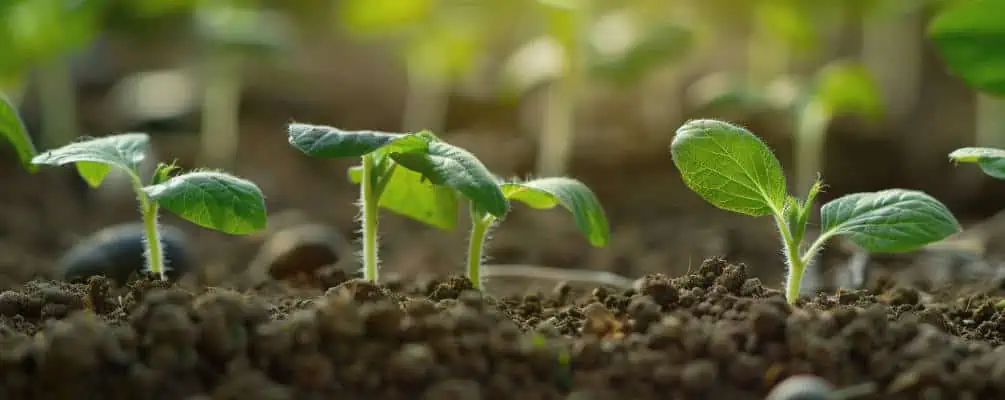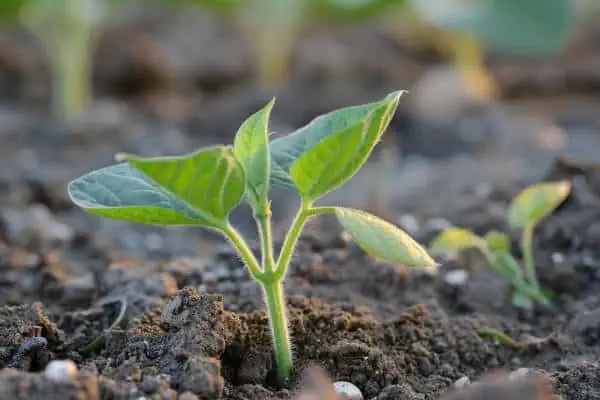Soybean growers anxiously await the tiny seedlings that signal a good stand and potential for high yields at harvest. But have you ever wondered what goes on underground between planting those small seeds and the emergence of their green shoots days later? The transformation from dry seed to growing plant involves a remarkable process driven by biology and the environment. Getting acquainted with the stages of germination will deepen growers’ appreciation for this transformative sequence. Just how does a soybean seed structurally change upon absorbing water? What triggers the radical elongating downward while the hypocotyl hooks upward to pull the cotyledons into daylight? Let’s dig in.

Imbibition Phase: Water Absorption
The imbibition phase marks the beginning of the soybean germination process. This is when the seed coat first takes up water from the surrounding soil through the process of imbibition. Imbibition allows the dry seed to rehydrate and revive its metabolic activity in preparation for growth.
The rate of water absorption during imbibition is remarkably fast—the moisture content of the seed can increase from around 13% to over 50% in just a few hours. If the soil is dry initially, the soybean seed draws water vapor from the spaces between soil particles first before absorbing liquid water. However, higher soil moisture saturation provides more available free water for faster hydration. As the seed absorbs water, its cells expand and metabolic processes restart. This prepares the way for the embryo inside to emerge and continue its transformation into a seedling. Optimal soil temperatures for imbibition range from 21-32°C (70-90 °F). Temperatures below 13°C (55°F) can slow down the rate of water absorption and thus delay emergence.
If the soil is dry initially, the soybean seed draws water vapor from the spaces between soil particles first before absorbing liquid water. However, higher soil moisture saturation provides more available free water for faster hydration. As the seed absorbs water, its cells expand and metabolic processes restart. This prepares the way for the embryo inside to emerge and continue its transformation into a seedling.
The duration of the imbibition phase sets the pace for the remainder of the germination process. Rapid water uptake allows the cells to quickly undertake the tasks necessary to support radicle and hypocotyl elongation. Slower imbibition due to cool soil temperatures or lack of soil moisture extends the timeline before active germination can commence. Growers should aim to provide adequate warmth and moisture to help their soybean seeds complete this threshold phase expeditiously.
Ideal Soil Moisture for Rapid Soybean Seeds to Germinate
While soybean seeds are able to imbibe water even from relatively dry soils, the rate of water absorption and overall germination timeline is quickest with ample available moisture. The optimal soil moisture level for rapid soybean germination is near field capacity. This is when pores in the soil are filled with adequate water while still allowing sufficient oxygen circulation.
Field capacity generally occurs after the soil has been saturated by rainfall or irrigation and then allowed to drain to equilibrium. The space left between soil particles retains moisture. At field capacity, roughly 60-85% of available pore space in the soil would be filled with water. This moist but not waterlogged condition maximizes both water availability and air penetration for the germinating seed’s respiration needs.
When soils are overly wet for long periods, it can impede germination and seedling health due to lack of oxygen circulation. On the other hand, if soils are too dry, the seed has difficulty absorbing enough moisture for the cells to undertake all the metabolic activities involved in transforming into a seedling. Both overly dry and saturated conditions lead to delays in emergence.
The ideal planting depth in moist soil also balances temperature and humidity exposure. Planting too shallow can expose seeds to drying conditions while planting too deep buries them in cooler layers with higher moisture. A depth of around 1.5 to 2 inches provides a good buffer from extremes. Monitoring and actively managing soil moisture levels before and after planting helps promote rapid, healthy germination.
Radicle Emergence: Primary Root Growth
As the soybean seed completes imbibition and its cells activate, the embryo inside begins to grow and elongate. The first visible structure to emerge is the radicle or primary root. This crucial anchor point will develop into the taproot system that secures the future plant.
In most cases, the radicle emerges through an opening the seed coat within 1-2 days after planting if soil temperatures are optimal. Its cells lengthen first downward, guided by gravity’s orientation toward moisture deeper in the soil profile. This initial vertical penetration helps anchor the seedling while also providing a conduit to draw up additional water and nutrients.
As the primary root extends longer, lateral roots branch off its sides, expanding the root system’s reach into the surrounding soil. These secondary roots further stabilize the seedling and absorb more essential nutrients and moisture. Root hairs also begin to develop along the entire root structure at this stage, vastly increasing the surface area for water and nutrient absorption.
Strong, rapid development of the radicle and lateral roots results in a healthier, more resilient soybean seedling. The root system provides the foundation that supports the young plant’s rapid upward growth. Delayed or stunted root establishment in cold, dry, or compacted soil can set back the timeline for emergence or result in abnormal seedlings. Ensuring proper soil conditions encourages the root’s quick support of subsequent hypocotyl and cotyledon development.
Hypocotyl Elongation: Stem Pushes Through Soil
Once the radicle anchors the soybean seedling and expands its root system, the next structure to undergo rapid cell elongation is the hypocotyl. This embryonic stem connects the root system to the cotyledons and shoot apex tucked within the seed.
Approximately 5-7 days after planting (depending on temperature), the hypocotyl begins extending upward, arching toward the soil surface. This pushing action is powered by cell elongation and expansion within the hypocotyl, fueled by the moisture, oxygen, and nutrition absorbed by the roots. The hypocotyl exhibits phototropism at this stage, orienting its growth toward sunlight just above the soil line.
The hypocotyl continues extending longer until it breaches through the soil surface. This involves a remarkable increase from its original minute size curled up inside the seed—in some varieties over 4 inches long! Its elongated cells literally lift and shove aside soil particles in the relentless reach toward light and air.
Once at the surface, exposure to light triggers key hormones that cause the hypocotyl to stop extending and begin assuming its role as the main stem of the soybean plant. Bending sharply like a hook, it then pulls the attached cotyledons and shoot above ground so they can fully open and begin photosynthesis. The epicotyl shoot will soon emerge between the open cotyledons.
The hypocotyl provides critical upward momentum to complete the emergence process. Ensuring strong, unimpeded hypocotyl development sets up the soybean plant for healthier subsequent vegetative growth and reproduction. This key transition depends on good moisture, temperature, oxygen, and prior root establishment.
Cotyledons Open: First Seed Leaves Appear
Soybean seeds harbor a pair of pre-formed seed leaves called cotyledons tucked inside their protective coat. As the hypocotyl continues elevating the soybean seedling through the soil, these cotyledons begin to emerge still folded together. Exposure to sunlight triggers the cotyledons to unfold and expand into the first embryonic leaves of the young plant.
The cotyledons are attached on either side of the shortened epicotyl located right above the arching hypocotyl. As they separate and flatten over hours to days, the epicotyl grows longer between them with its apex bud protected. The delicate apical meristem tissues here will later form the first true leaves and shoots.
It takes some time for the cotyledons to complete their transformation—switching from pale yellow storage organs to green photosynthetic factories. They firstly rely on food reserves from the seed itself before building their capacity to harvest sunlight. The vascular system connecting them to the hypocotyl and roots also develops more robust pathways for water and nutrients.
Once fully expanded and green, the cotyledons begin generating energy from light and atmospheric carbon to fuel the soybean seedling’s further shoot growth. This marks the transition from embryo to autotrophic plant. The cotyledons’ large surface area absorbs ample sunlight for food production even as the first simple leaves start unfolding behind them.
Successful opening and greening of the cotyledons marks a major milestone in the plant’s establishment. Exposure to frost, hail damage, or herbicide contact at this stage can set back growth. Growers should aim to build early resilience before exposing delicate cotyledons.
Emergence Above Ground: Hypocotyl and Cotyledons Visible
When the arching hypocotyl and unfolding cotyledons finally emerge from the soil after their journey upward, this milestone marks the soybean seed’s complete transformation into a viable seedling now visible above ground. The process spans below-ground activity invisible to the farmer as well as the first visible signs of life.
It starts with that very first imbibition of water to restart cell metabolism in the quiescent seed. A cascade then ensues—radicle anchoring down, hypocotyl reaching upward, cotyledons expanding to catch sunlight. Emergence represents the summit when all embryonic structures activate to support now autonomous growth. The young soybean plant switches nutritional reliance from seed reserves to soil root absorption and air-powered photosynthesis in the leaves.
The plant remains vulnerable at this early stage to weather, pests, and mechanical damage. But with continued seasonal warmth and moisture, its structures strengthen quickly as true leaves unfold and shoots elongate. Soon one emergent appears identical to its neighbor, uniform stand rows promising their bounty to come.
Key Factors Influencing Soybean Germination Rate
Many variables interact to determine the speed and success of soybean germination after planting. Understanding these influential factors empowers growers to make proactive decisions that optimize field conditions and set up their crop for rapid, uniform emergence.
Soil Temperature Effects
Soil temperature plays a critical role regulating the pace of germination. Enzyme activity that mobilizes food reserves and fuels growth in the seedling can only proceed within certain temperature ranges.
Adequate Soil Moisture
While soybean seeds can germinate even in relatively dry soils by absorbing water vapor from soil pores, optimal moisture levels accelerate the sequence.
Good Seed-Soil Contact
The soybean seed relies on excellent contact with surrounding soil particles to facilitate transport of water and nutrients into the structures developing from the embryo.
Warm, Sunny Conditions After Emergence
Once above ground, the young soybean seedling remains vulnerable to stresses like damage from winds, hail, heavy rain, herbicide exposure, insect feeding, and disease pathogens.
But given adequate warmth, moisture, and sunlight after emergence, the small structures can continue vigorous growth with low mortality if protected from external threats.
Soybean Germination Timeline Through to Emergence
From the very first uptake of water to the unfurling of the cotyledons in the morning light, the soybean seed disappears below ground to transform before again revealing itself in a new plant form. The stages of germination proceed sequentially in a continuum—imbibition allows cells to activate metabolism; radicle roots down while hypocotyl reaches upward toward sunlight; cotyledons open as the first true embryonic leaves.
The full progression takes 5-12 days under optimal temperature and moisture conditions before the seedling finally emerges from the soil. Each prior development must advance sufficiently to support the next rise in complexity—from water and food mobilization at the biochemical level to tissue growth and organ differentiation at the anatomical level.
Farmers invest patience alongside timely management inputs to shepherd fields from latent potential to visible rows. What better stand could they hope for than vigorous green cotyledons all facing the dawn together, beginning their sprint toward flowering and fruiting? Soon the novice plants will cover all evidence their elderly ancestor’s seeds ever disrupted the ground there at all. All that remains is nurturing their determined drive toward maturity.

